In Part 1, I described my journey to Birkenhead's Hamilton Square station by train on the 8th February 2014.
In Part 2, I described my exploration on foot around Birkenhead's docks.
In this part, I'll describe re-visiting New Brighton.
My first visit to New Brighton
I think I was seven or eight when I made my first visit to New Brighton with my mother and father for a few days holiday. I thought it was marvellous. Despite its proximity to Liverpool with its docks, it was a 'proper seaside' with an excellent sandy beach, promenades, a lighthouse, a pier (from where it was possible to sail to Liverpool by Mersey Ferry) and an amusement park with a real steam miniature railway.
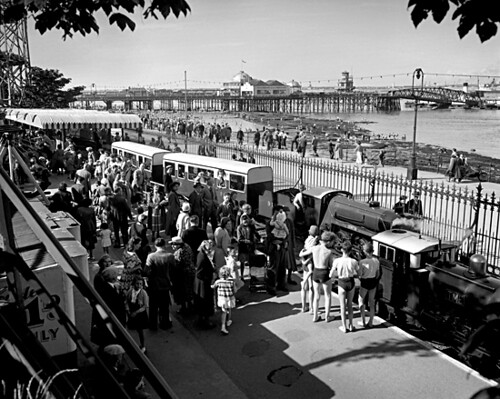 Tommy Mann's railway ran at New Brighton from 1948 to 1965. The pier and ferry landing stage can be seen in the background (Photo: 'Reflections').
Tommy Mann's railway ran at New Brighton from 1948 to 1965. The pier and ferry landing stage can be seen in the background (Photo: 'Reflections').
We stayed in a boarding house which I think was towards Wallasey. A guest there during our visit was Billy Scott Coomber. I knew nothing of his fame as a singer and musician both in his own right and with the Jack Payne Orchestra but he was a very kindly, humorous man who made mealtimes at the hotel very jolly.
Brief railway history
The Wirral Railway was incorporated in 1862 as the Hoylake Railway, finally becoming the Wirral Railway in 1882. It comprised the line from Birkenhead Park (where it made an end-on connection with the Mersey Railway line from Hamilton Square) through Birkenhead North to a triangular junction east of Bidston Station. One branch continued via Bidston Station (where a branch from Wrexham joined) to West Kirby, the other branch went on to New Brighton, with a second triangular junction serving a branch to Seacombe, which had a ferry service to Liverpool. There's a short Wikipedia article here. At the grouping, the line became part of the L.M.S., continuing to use steam locomotives until electrification at 650v d.c. third rail in 1938. Metro-Cammell and Birmingham Railway Carriage and Wagon built the successful 3-car Electric Multiple Units (classified by British Railways as Class 503). For a time, the new trains worked alongside earlier Mersey Railway units until they were replaced. In 1985, the Class 503 were, in turn, replaced by Class 507 and Class 508 units which handle the services now.
By train to New Brighton
There are a number of stations on the line to New Brighton from the junction with the Rock Ferry line at Hamilton Square:-
Hamilton SquareMy walking tour of the docks took me from Hamilton Square to Birkenhead North where I intended to catch the first train to either West Kirby or New Brighton. In common with other Wirral Railway stations, Birkenhead North is provided with neat, brick buildings. It's currently undergoing a major rebuilding - the original footbridge has been demolished to allow a modern replacement to be constructed and, in the meantime, a temporary affair has been erected at the Bidston end of the station.
Conway Park
Birkenhead Park
Birkenhead North
Wallasey Village
Wallasey Grove Road
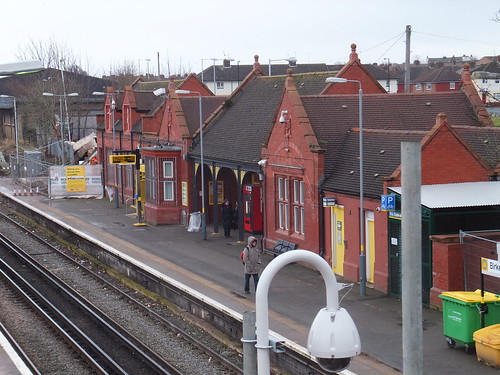 Birkenhead North Station, viewed from the temporary footbridge.
Birkenhead North Station, viewed from the temporary footbridge.
The first train was for New Brighton and we were soon curving to the right, away from the West Kirby Line, and passing the modern maintenance depot which handles all the rolling stock on the Merseyrail network.
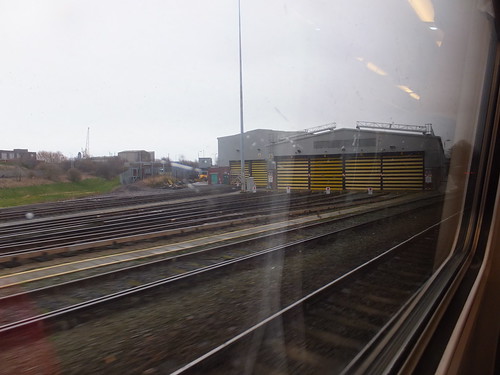 Birkenhead North Traction and Rolling Stock Maintenance Depot.
Birkenhead North Traction and Rolling Stock Maintenance Depot.
I could just make out the overgrown remains of the junction which originally led to Seacombe and the iron ore sidings (which received foreign ore by ship which was sent by rail to the steelmaking plant at Shotton). We made a brief stop first at Wallasey Village Station and then, just a quarter of a mile further on, at Wallasey Grove Road Station. The rain was sluicing down the windows as we travelled the final mile and a half to the terminus at New Brighton. It was still raining as I crossed the road to admire the station frontage.
 New Brighton Station Building from the road.
New Brighton Station Building from the road.
The station sits on a hill at the back of the town, in a residential area of dignified early 20th-century development. I look the steep road leading down to the promenade where there was a large, well-filled car park. As I reached the bottom of the hill, I discovered a large block of modern buildings on my right - a Morrisons Supermarket, Travelodge Hotel and various other restaurants. I don't think this retail park was there on my last visit. I suffered the same lack of recognition I experienced on my December trip to Morecambe and Heysham (described here) on discovering the modern retail park on the front at Morecambe. At New Brighton, I had a similar sense of alienation looking out to sea, as the view took in the offshore wind turbines of the Burbo Bank Array.
 The Burbo Bank Array.
The Burbo Bank Array.
It was only a few weeks previously that I had been reminded of the extent of the wind farm industry on my trip to Holyhead (described here).
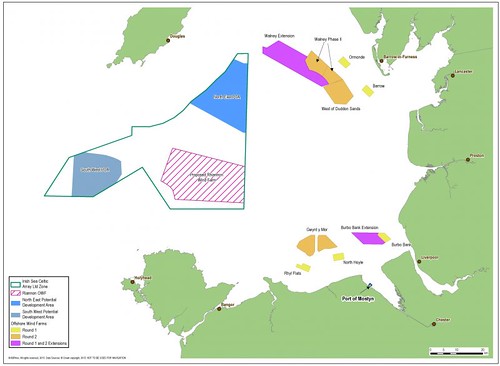
Click for larger view
Map showing the Burbo Bank Array and other offshore wind farms.
It was raining and blowing a gale but the beach still looked inviting. I took a picture from the sands showing the older part of the town.
 New Brighton: View of the town from the beach.
New Brighton: View of the town from the beach.
Looking across the Mersey estuary, you can still see Liverpool and its docks. When I was young, that was a bonus. Living inland, I rarely saw big ships and the beach at New Brighton offered unrivalled views of the almost continuous parade of ships of all kinds. The lighthouse at Fort Perch Rock was an important navigational mark but, with the advent of shipborne radar, it was taken out of use. It still stands proudly on the beach.
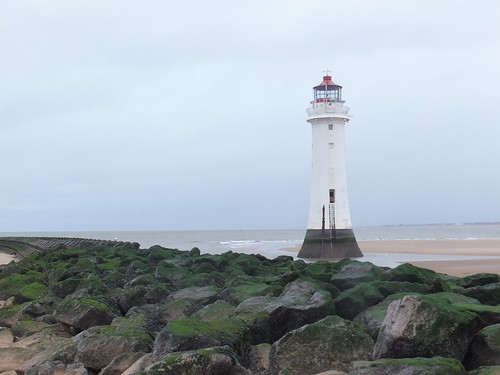 Fort Perch Rock Lighthouse.
Fort Perch Rock Lighthouse.
I decided to walk back to the railway station before I became too wet, too cold or too tired to make the journey. I caught the next departure, alighting at Hamilton Square. I explored the underground passages connecting the station's three platforms for a few minutes whilst waiting for the next train towards Rock Ferry. The next service was for Ellesmere Port - I took this train to Hooton and spent a few minutes taking pictures whilst waiting for the following train which was for Chester. After a short wait at Chester, there was a 2-car diesel to Crewe out of bay platform 1. Finally, at Crewe I caught a London Midland Liverpool-Birmingham 4-car Electric Multiple Unit for the last leg by rail back to Wolverhampton.
My day was very enjoyable, despite arriving home tired and a little bedraggled.
Related articles on other sites
Reflections (features a host of historical pictures).
The New Brighton History Site.
Related posts in this blog
Birkenhead and New Brighton by train (Part 1)
Birkenhead and New Brighton by train (Part 2)
My pictures
Merseyrail.
New Brighton.
North Wales Line (Crewe - Llandudno).
